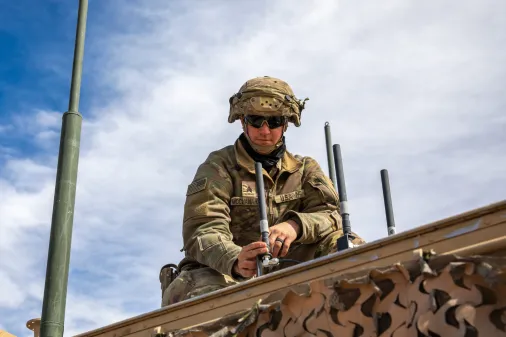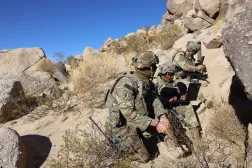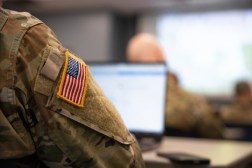To be ready for conflict, Army leader urges focus on information space in ‘competition’

To be effective in future conflicts, the Army must pay attention to and be present in the information domain prior to when a crisis unfolds, known as the “competition phase,” according to a top commander.
With new forces and organizations beginning to take shape, the service is determining how it can apply military power across the spectrum of hostilities.
“The information dimension is a place [where] we are in a persistent conflict right now … It is going to be crucially important to us — how do we think through how to apply military power across the spectrum of conflict?” Lt. Gen. Maria Barrett, commander of Army Cyber Command, said during a presentation at an Association of the United States Army event on Tuesday. “We might reserve this discussion to, oh it’s just to conflict or just to crisis. But in fact, the competition space, this is where it’s happening now. If you think you’re going to deliver options to a commander, insights to a commander about the information dimension and you are not looking at it in the competition phase, whatever you are delivering in crisis and conflict probably will fall short. You need to be prepared to be operating across that spectrum.”
One reason it’s important to stay engaged is that the barrier to entry is very low in the information space, Barrett noted. Technologies and mediums such as social media make it easy for unsophisticated actors or tactics to have an impact. However, those tactics can be enhanced by ever-advancing capabilities that are becoming more prevalent.
“What happens when you have a very capable adversary that can make the investment in artificial intelligence, and what does that then do to the information dimension?” she said. “I think these are serious considerations for all of us and the fact that this particular dimension, again, activities will happen across the spectrum of conflict, below the threshold of war, it’s important for us to consider what is our role.”
Officials across the U.S. military, not just the Army, have been talking about the need to be present in this competition phase, short of armed conflict, for a few years. While the Pentagon has historically taken a binary approach of war or peace, adversaries have seen conflict as a fluid continuum. In recent years, they have sought to exploit the information space to achieve their objectives without using traditional military capabilities.
Officials said some of this isn’t all that unfamiliar and it boils down to being able to map the environment with commercially available information ahead of time while keeping in place protections for U.S. persons.
“Commercially available information, publicly available information — those are areas where you can start to get a sense of what the information environment looks like, how the adversary uses it, what kind of tools they use. It’s actually something that you can start to map,” Barrett told reporters following the event. “Something that is actually in our wheelhouse to do is mapping networks. I do think this is something that will come easier to us in terms of mapping data.”
This includes being able to understand target audiences, what languages they speak, how they communicate, what social media platforms they use, and whether they’re pro or anti-U.S. or they support or oppose certain actors or other nations.
Officials also explained that if forces want to put a concept or an operation forward for approval, the work needs to be done on the front end to be able to determine how it will be carried out based on the intelligence and what’s known.
“If you go to a geographic combatant commander and say, ‘I want to conduct information operations,’ you’ll walk right back out of the headquarters having achieved nothing,” Maj. Gen. Paul Stanton, commander of the Cyber Center of Excellence, said at the AUSA event. “In contrast, if you’ve done your planning, you’ve done your homework and you walk in and say, ‘Here is the very specific objective that I am attempting to achieve, this is how it nests into my campaign plan that supports your campaign plan as the geographic combatant commander,’ that’s a fundamentally different conversation.”
New forces
The planning and expertise to be able to enable these operations comes from the Army’s Theater Information Advantage Detachments, 65-person teams focused on synchronizing information capabilities at the theater level.
The Army recently approved the force structure for three such organizations: one in the Pacific, one in Europe and a transregional one with Army Cyber Command.
Officials explained they will be doing the day-to-day business of setting the conditions and informing commanders of the information environment.
“This is all for the purpose of enabling commanders to visualize and decide and again synchronize these effects that they could have in this dimension much better than they can today,” Barrett said.
Those TIADs will be taking what might be abstract to something concrete.
“The TIAD has to do all detailed planning, they have to do the data collection, they have to get the approvals in order to execute mission, and then they have to do the appropriate assessment of effectiveness after the fact,” Stanton told reporters.
He noted that while not there yet, the detachments are likely headed towards collaborating more with international partners in their regions to share information on potential threats.
One of the main reasons this type of formation must exist at the theater Army level, is because that’s where many of the authorities exist and coordination between other nations’ militaries and diplomatic officials occurs at the theater level.
“We need to develop the right very detailed plan and walk that forward through the interagency and other governmental organizations for the right approval to say, ‘OK, in this particular case, based off of the specifics that you described, we should establish an information-sharing agreement with the host nation because of dependencies on the execution of our mission on their operating environment.’ I absolutely believe that there’s space for that conversation [but] we’re not doing it currently,” Stanton said.






